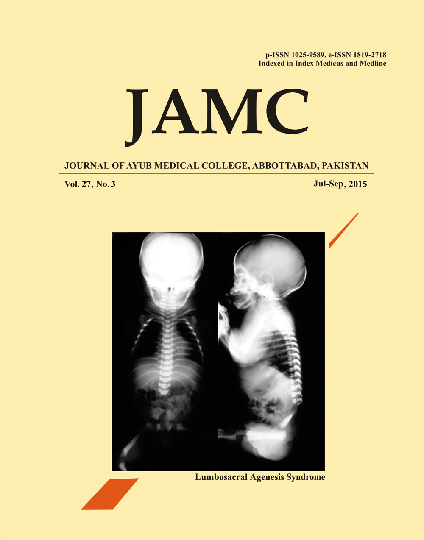CLINICAL PRESENTATION, AETIOLOGY AND COMPLICATIONS OF PANCREATITIS IN CHILDREN
Abstract
Background: Childhood Pancreatitis is an uncommon but serious condition with incidence on the rise. It manifests as acute or chronic form with epigastric pain, vomiting and elevated serum amylase and lipase. This study was conducted with the aim to determine the clinical presentation, aetiology, and complications of pancreatitis in children. Methods: This descriptive case series was conducted in the Department of Paediatric Gastroenterology, Hepatology and Nutrition, The Children’s Hospital & the Institute of Child Health, Lahore from 1st January to 31st December 2014. Seventy-two patients up to the age of 15 years having abdominal pain, Amylase >200 IU/L and/or lipase >165 IU/L, with features of acute or chronic pancreatitis on abdominal imaging; were included in study. Data analysis was done using SPSS-20. Results: Of the total 72 patients, 43 (60%) had acute pancreatitis, males were 25 (58%) and females 18 (42%) and chronic pancreatitis was diagnosed in 29 (40%), males 10 (34%) and females 19 (66%). Common clinical features were abdominal pain (100%), nausea and vomiting (79%). common aetiologies were idiopathic (40%) while choledochal cyst 8%, hyperlipidaemia 7%, biliary tract stones/sludge 7% and abdominal trauma 6%. Complications were more frequently associated with acute pancreatitis (60%) than with chronic pancreatitis (34%). Common complications were pseudopancreatic cyst (36%), ascites (17%) and pleural effusion (4%). Conclusion: Abdominal pain, nausea and vomiting were common presenting features of childhood pancreatitis. Common aetiologies were idiopathic. hyperlipidemia, biliary tract stones/sludge, choledochal cyst and abdominal trauma. Common complications were Pseudopancreatic cyst, ascites and pleural effusion.References
Bai HX, Lowe ME, Husain SZ. What have we learned about acute pancreatitis in children? J PediatrGastroenterolNutr 2011;52(3):262–70.
Morinville VD, Barmada MM, Lowe ME. Increasing incidence of acute pancreatitis at an American pediatric tertiary care center: is greater awareness among physicians responsible? Pancreas 2010;39(1):5–8.
Chowdhury SD, Chacko A, Ramakrishna BS, Dutta AK, Augustine J, Koshy AK, et al. Clinical profile and outcome of chronic pancreatitis in children.Indian Pediatr 2013;50(11):1016–9.
Banks PA, Conwell DL, Toskes PP. The management of acute and chronic pancreatitis. GastroenterolHepatol (N Y). 2010;6(2 Suppl 3):1–16.
Mirza B. Pancreatic calcification. APSP J Case Rep 2010;1(1):11.
Das S, Arora NK, Gupta DK, Gupta AK, Mathur P, Ahuja A. Pancreatic diseases in children in a north Indian referral hospital. Indian Pediatr 2004;41(7):704–11.
Park AJ, Latif SU, Ahmad MU, Bultron G, Orabi AI, Bhandari V, et. al. A comparison of presentation and management trends in acute pancreatitis between infants/toddlers and older children. J Pediatr Gastroenterol Nutr 2010;51(2):167–70.
Gómez Beltrán O, Roldán Molleja L, Garrido Pérez JI, Medina Martínez M, Granero Cendón R, González de Caldas Marchal R, et al. [Acute pancreatitis in children]. Cir Pediatr 2013;26(1):21–4.
Midha S, Singh N, Sachdev V, Tandon RK, Joshi YK, Garg PK. Cause and effect relationship of malnutrition with idiopathic chronic pancreatitis: prospective case-control study. J Gastroenterol Hepatol 2008;23(9):1378–83.
MekitarianFilho E, Carvalho WB, Silva FD. Acute pancreatitis in pediatrics: a systematic review of the literature. J Pediatr (Rio J) 2012;88(2):101–14.
Das S, Arora NK, Gupta DK, Gupta AK, Mathur P, Ahuja A. Pancreatic diseases in children in a north Indian referral hospital. Indian Pediatr 2004;41(7):704–11.
Antunes H, Nascimento J, Mesquita A, Correia-Pinto J. Acute pancreatitis in children: a tertiary hospital report. Scand J Gastroenterol 2014;49(5):642–7.
Tiao MM, Chuang JH, Ko SF, Shieh CS, Huang SC, Liang CD, et al. Pancreatic pseudocysts in children. Chang Gung Med J 2000;23(12):761–7.
Neoptolemos JP, Winslet MC. Pancreatic Ascites, In: Berger HG, Buchler M, Ditshuneit H, Malfertheiner P. (editors) Chronic Pancreatitis, Berlin, Springer Berlin Heidelberg 1990;269–79.
Aswani Y, Hira P. Venous complications of pancreatitis: a review. JOP 2015;16(1):20–4.
Park WS, Kim HI, Jeon BJ, Kim SH, Lee SO. Should anticoagulants be administered for portal vein thrombosis associated with acute pancreatitis? World J Gastroenterol 2012;18(42): 6168–71.
Sakorafas GH, Tsiotou AG. Splenic-vein thrombosis complicating chronic pancreatitis. Scand J Gastroenterol 1999;34(12):1171–7.
Izbicki JR, Yekebas EF, Strate T, Eisenberger CF, Hosch SB, Steffani K, et al. Extrahepatic portal hypertension in chronic pancreatitis: an old problem revisited. Ann Surg 2002;236(1):82–9.
Benifla M, Weizman Z. Acute pancreatitis in childhood: analysis of literature data. J Clin Gastroenterol 2003;37(2):169–72.
Tiao MM, Chuang JH, Ko SF, Kuo HW, Liang CD, Chen CL. Pancreatitis in children: clinical analysis of 61 cases in southern Taiwan. Chang Gung Med J 2002;25(3):162–8.
Published
Issue
Section
License
Journal of Ayub Medical College, Abbottabad is an OPEN ACCESS JOURNAL which means that all content is FREELY available without charge to all users whether registered with the journal or not. The work published by J Ayub Med Coll Abbottabad is licensed and distributed under the creative commons License CC BY ND Attribution-NoDerivs. Material printed in this journal is OPEN to access, and are FREE for use in academic and research work with proper citation. J Ayub Med Coll Abbottabad accepts only original material for publication with the understanding that except for abstracts, no part of the data has been published or will be submitted for publication elsewhere before appearing in J Ayub Med Coll Abbottabad. The Editorial Board of J Ayub Med Coll Abbottabad makes every effort to ensure the accuracy and authenticity of material printed in J Ayub Med Coll Abbottabad. However, conclusions and statements expressed are views of the authors and do not reflect the opinion/policy of J Ayub Med Coll Abbottabad or the Editorial Board.
USERS are allowed to read, download, copy, distribute, print, search, or link to the full texts of the articles, or use them for any other lawful purpose, without asking prior permission from the publisher or the author. This is in accordance with the BOAI definition of open access.
AUTHORS retain the rights of free downloading/unlimited e-print of full text and sharing/disseminating the article without any restriction, by any means including twitter, scholarly collaboration networks such as ResearchGate, Academia.eu, and social media sites such as Twitter, LinkedIn, Google Scholar and any other professional or academic networking site.









